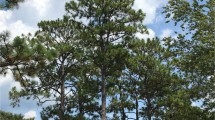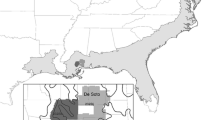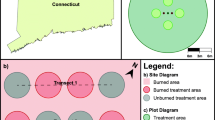Abstract
College and university campuses comprise a unique urban interface. Property used to establish the University of West Florida (UWF) in Pensacola, Florida, contained numerous ecological features, including natural areas with remnant longleaf pine stands that had undergone recovery from extensive regional logging. The two most prominent of these were studied to quantify the effects of chronic fire exclusion on longleaf pine stands. We addressed these questions: (1) how does composition and structure vary between areas? (2) how do soil characteristics vary between areas and change under fire exclusion? (3) what is the size structure of longleaf pine on the UWF campus? (4) how does the status of longleaf pine at the UWF campus compare to campuses of other colleges/universities within the nature range of longleaf pine? Fifteen 0.04 ha circular plots were established in each area to assess composition and structure and sample mineral soil. All live stems ≥2.5 cm diameter at breast height (DBH) in each plot were identified to species and measured for DBH to the nearest 0.1 cm. Mineral soil was taken to a 5-cm depth, air dried, and analyzed for pH, organic matter, cation exchange capacity, extractable macro- and micronutrients, and extractable aluminum. Basal area and density were closely similar between the natural areas, as was canopy dominance (live oak and longleaf pine), but with contrasting sub-dominant species. Soil analyses revealed no significant differences between natural areas, but suggested that fire exclusion decreased soil organic matter and fertility with establishment of hardwood species. Diameter structure of longleaf pine contrasted sharply between natural areas and with the main campus, suggesting different land-use history. The wide array of approaches to longleaf pine ecology by colleges/universities within its natural range indicates the importance of establishing a longleaf pine consortium to coordinate information.






Similar content being viewed by others
Data availability
All data from this study are available from FSG upon request.
References
Addington RN, Knapp BO, Sorrell GG, Elmore ML, Wang GG, Walker JL (2015) Factors affecting broadleaf woody vegetation in upland pine forests managed for longleaf pine restoration. For Ecol Manag 354:130–138
Barton AM, Keeton WS (2018) Ecology and recovery of eastern old-growth forests. Island Press, Washington, DC
Bartram W (1791) Travels through North and South Carolina, Georgia, East and West Florida. Dover Publications, New York
Berish JED, Leone EH (2014) Follow-up demographic survey of a Florida gopher tortoise population. Southeast Nat 13:639–648
Castellón TD, Rothermel BB, Bauder JM (2018) Gopher tortoise burrow use, home range, seasonality, and habitat fidelity in scrub and Mesic Flatwoods of southern Florida. Herpetologica 74:8–21
Chapman HH (1932) Is the longleaf type a climax? Ecology 13:328–334
Cipollini M, Felch P, Dingley NR, Maddox C (2019) Changes in tree canopy, understory vegetation, and fuel composition after 10 years of restoration management in an old-growth mountain longleaf pine forest. Nat Areas J 39:197–211
Cipollini ML, Culberson J, Stripplehoff C, Baldvins T, Miller K (2012) Herbaceous plants and grasses in a mountain longleaf pine forest undergoing restoration: a survey and comparative study. Southeast Nat 11:637–668
Cole K, Bennington C (2017) From the ground up: natural history education in an urban campus restoration. Southeast Nat 16:132–145
Copenheaver CA, Seiler JR, Peterson JA, Evans AM, McVay JL, White JH (2014) Stadium woods: a dendroecological analysis of an old-growth forest fragment on a university campus. Dendrochronologia 32:62–70
Daubenmire R (1990) The Magnolia grandiflora-Quercus virginiana forest of Florida. Am Midl Nat 123:331–347
Dickens C (1842) American notes for general circulation, Vol. 1. Chapman and Hall, London
Francos M, Stefanuto EB, Úbeda X, Pereira P (2019) Long-term impact of prescribed fire on soil chemical properties in a wildland-urban interface. Northeastern Iberian Peninsula. Sci Tot Environ 689:305–311
Gilliam FS (2016) Forest ecosystems of temperate climatic regions: from ancient use to climate change. New Phytol 212:871–887
Gilliam FS, Platt WJ (1999) Effects of long-term fire exclusion on tree species composition and stand structure in an old-growth Pinus palustris (longleaf pine) forest. Plant Ecol 140:15–26
Gilliam FS, Platt WJ (2006) Conservation and restoration of the longleaf pine ecosystem. Appl Veg Sci 9:7–10
Gilliam FS, Yurish BM, Goodwin LM (1993) Community composition of an old-growth longleaf pine forest: relationship to soil texture on tree species. Bull Torrey Bot Club 120:287–294
Gilliam FS, Platt WJ, Peet RK (2006) Natural disturbances and the physiognomy of pine savannas: a phenomenological model. Appl Veg Sci 9:83–96
Gilliam FS, Harmon EE, Boyles SC (2020a) The University of West Florida campus ecosystem study: gopher tortoise and longleaf pine populations in an urban interface. Urban Ecosyst 23:355–362
Gilliam FS, Adams MB, Peterjohn WT (2020b) Response of soil fertility to 25 years of experimental acidification in a temperate hardwood forest. J Environ Qual 49:961–972
Goodman SJ, Smith JA, Gorman TA, Haas CA (2018) Longevity of gopher tortoise burrows in sandy soils. Southeast Nat 17:531–540
Henderson A (1949) Campus of the first state university. The University of North Carolina Press, Chapel Hill
Heyward F (1939) The relation of fire to stand composition of longleaf pine forests. Ecology 20:287–304
Hiers JK, O’Brien JJ, Will RE, Mitchell RJ (2007) Forest floor depth mediates understory vigor in xeric Pinus palustris ecosystems. Ecol Appl 17:806–814
Hiers JK, Walters JR, Mitchel RJ, Varner JM, Conner LM, Blanc LA, Stowe J (2014) Ecological value of retaining pyrophytic oaks in longleaf pine ecosystems. J Wildlife Manage 78:383–393
Jarvis JE (2008) The next larger picture: an anecdotal history of the master planning of the campus of the University of West Florida and the design and construction of its buildings for the initial thirty-something years; a memoir, of sorts. Pioneer Series/University of West Florida Foundation, Inc, Pensacola
Kaczor SA, Hartnett DC (1990) Gopher tortoise (Gopherus polyphemus) effects on soils and vegetation in a Florida sandhill community. Am Midl Nat 123:100–111
Kirkman LK, Jack SB (2018) Ecological restoration and management of longleaf pine forests. CRC Press, Boca Raton
Knapp DD, Howze JM, Murphy CM, Dziadzio MC, Smith LL (2018) Prescribed fire affects diurnal vertebrate use of gopher tortoise (Gopherus polyphemus) burrows in a longleaf pine (Pinus palustris) forest. Herpetolog Conserv Biol 13:551–557
Knight GR, Oetting JB, Cross L (2011) Atlas of Florida’s natural heritage—biodiversity, landscapes, stewardship, and opportunities. Institute of Science and Public Affairs. Florida State University, Tallahassee
Kronenberger J, Cipollini M, Baldvins T, Montgomery A, Simpson A (2014) Vegetative and bird community response to management in a mountain longleaf pine forest. Nat Areas J 34:8–23
Lynch (2006) The Duke Forest at 75: a resource for all seasons. Duke University Press, Durham
Marschner H (2012) Mineral nutrition of higher plants, 3rd edn. Academic Press, London
Marse C (2007) Rising fiery constellation: a portrait of the University of West Florida from birth to forty. Pioneer Series, Pensacola
McHarg IL (1995) Design with nature, 25th edn. John Wiley & Sons, Hoboken
Moore LD, JT Van Stan II, TE Gay, C Rosier, T Wu (2016) Alteration of soil chitinolytic bacterial and ammonia oxidizing archaeal community diversity by rainwater redistribution in an epiphyte-laden Quercus virginiana canopy. Soil Biol Biochem 100:33–41
Muller RN (2014) Nutrient relations of the herbaceous layer in deciduous forest ecosystems. In: Gilliam FS (ed) The herbaceous layer in forests of eastern North America, 2nd edn. Oxford University Press, New York, pp 13–34
Neufeld HS, Young DR (2014) Ecophysiology of the herbaceous layer in temperate deciduous forests. In: Gilliam FS (ed) The herbaceous layer in forests of eastern North America, 2nd edn. Oxford University Press, New York, pp 35–95
Noel JM, Platt WJ, Moser EB (1998) Characteristics of old and second growth stands of longleaf pine (Pinus palustris) in the Gulf coastal region of the U.S.A. Cons Biol 12:533–548
Platt WJ (1999) Southeastern pine savannas. In: Anderson RC, Fralish JS, Baskin J (eds) The savanna, barrens, and rock outcrop plant communities of North America. Cambridge University Press, Cambridge, pp 23–51
Platt WJ, Evans GW, Rathbun SL (1988) The population dynamics of a long-lived conifer (Pinus palustris). Am Nat 131:491–525
Platt WJ, Carr SM, Reilly M, Fahr J (2006a) Pine savanna overstorey influences on ground-cover biodiversity. Appl Veg Sci 9:37–50
Platt WJ, Huffman JM, Slocum MG, Beckage B (2006b) Fire regimes and trees in Florida dry prairie landscapes. In Noss RF, ed, Land of fire and water: the Florida dry prairie ecosystem. Proceedings of the Florida Dry Prairie Conference
Provencher L, Litt AR, Gordon DR (2003) Predictors of species richness in Northwest Florida longleaf pine sandhills. Conserv Biol 17:1660–1671
Roman LA, Fristensky JP, Eisenman TS, Greenfield EJ, Lundgren RE, Cerwinka CE, Hewitt DA, Welsh CC (2017) Growing canopy on a college campus: understanding urban forest change through archival records and aerial photography. Environ Manag 60:1042–1061
Schroth AW, Friedland AJ, Bostick BC (2007) Macronutrient depletion and redistribution in soils under conifer and northern hardwood forests. Can J For Res 71:457–468
Šmilauer P, Lepš J (2014) Multivariate analysis of ecological data using CANOCO 5, 2nd edn. Cambridge University Press, Cambridge
Turner PV (1984) Campus: an American planning tradition. MIT Press, Cambridge
Varner JM, Gordon DR, Putz FE, Hiers JK (2005) Restoring fire to long-unburned Pinus palustris ecosystems: novel fire effects and consequences for long-unburned ecosystems. Restor Ecol 13:536–544
West JB, Espeleta JF, Donovan LA (2004) Fine root production and turnover across a complex edaphic gradient of a Pinus palustris—Aristida stricta savanna ecosystem. For Ecol Manag 189:397–405
Zar JH (2009) Biostatistical analysis, 5th edn. Prentice-Hall, Englewood Cliffs
Acknowledgments
We thank the UWF Office of Undergraduate Research for financial support via the Summer Undergraduate Research Program for funding for field supplies and soil analyses. We thank James R. Burkhalter, curator, Michael I. Cousins Herbarium of the University of West Florida (UWFP), for his expertise on the flora of Florida. We are deeply grateful to Cynthia C. Bennington (Stetson University), Martin L. Cipollini (Berry College), and David A. Fox (University of Florida) for their insights into longleaf pine at their respective campuses.
Funding
This work was not supported by external funding.
Author information
Authors and Affiliations
Contributions
FSG and SJD conceived the research; SJD, KDB, EAM, and FSG collected the data; FSG analyzed the data; FSG, SJD, KDB, and EAM wrote the paper.
Corresponding author
Ethics declarations
Conflict of interests
The authors have no conflict of interest to declare.
Informed consent
Not applicable.
Consent for publication
All authors consent for this paper to be published.
Research involving human participants and/or animals
Not applicable.
Rights and permissions
About this article
Cite this article
Gilliam, F.S., Detzel, S.J., Bray, K.D. et al. The University of West Florida campus ecosystem study: the college/university campus as a unit for study of the ecology of longleaf pine. Urban Ecosyst 24, 1073–1082 (2021). https://doi.org/10.1007/s11252-021-01103-9
Accepted:
Published:
Issue Date:
DOI: https://doi.org/10.1007/s11252-021-01103-9




